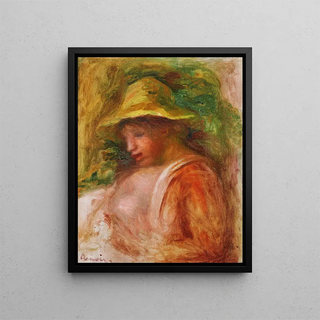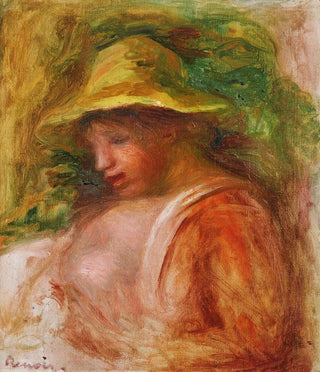Art print | Woman with Hat - Pierre-Auguste Renoir


View from behind

Frame (optional)
In the vast panorama of art history, some works transcend their era to become timeless symbols. "Femme au chapeau," painted by Pierre-Auguste Renoir in 1881, is undoubtedly one of these iconic creations. This canvas, vibrant with colors and emotions, evokes an atmosphere of joy and lightness. By contemplating it, the viewer is immediately immersed in the intimate world of 19th-century Parisian life, where beauty and modernity meet. Renoir, with his bold palette and innate sense of movement, manages to capture not only the appearance of his model but also the very essence of her spirit.
Style and uniqueness of the work
Renoir's style in "Femme au chapeau" is a perfect illustration of Impressionism, but it goes beyond mere impressions of light and color. The piece stands out through its daring use of contrasts and fluid brushstrokes that breathe vibrant life into the canvas. The female figure, dressed in a delicate dress and adorned with an extravagant hat, is depicted with such energy that her movement can almost be perceived. The shimmering colors, ranging from bright greens to deep reds, create a festive atmosphere, while the blurred background, where touches of light mingle, enhances the sense of depth and intimacy. This approach, which focuses on expressing feelings rather than realistic representation, makes this work a centerpiece of modern art.
The artist and his influence
Pierre-Auguste Renoir, an emblematic figure of Impressionism, reinvented painting by capturing the beauty of everyday life with a unique sensitivity. Born in 1841, Renoir was a pioneer in exploring effects of light and color. His work profoundly influenced not only his contemporaries but also future generations of artists. "Femme au chapeau" is a perfect example of his ability to marry technique and emotion, transforming fleeting moments into enduring works. Renoir also played a crucial role in establishing Impressionism.

Matte finish

View from behind

Frame (optional)
In the vast panorama of art history, some works transcend their era to become timeless symbols. "Femme au chapeau," painted by Pierre-Auguste Renoir in 1881, is undoubtedly one of these iconic creations. This canvas, vibrant with colors and emotions, evokes an atmosphere of joy and lightness. By contemplating it, the viewer is immediately immersed in the intimate world of 19th-century Parisian life, where beauty and modernity meet. Renoir, with his bold palette and innate sense of movement, manages to capture not only the appearance of his model but also the very essence of her spirit.
Style and uniqueness of the work
Renoir's style in "Femme au chapeau" is a perfect illustration of Impressionism, but it goes beyond mere impressions of light and color. The piece stands out through its daring use of contrasts and fluid brushstrokes that breathe vibrant life into the canvas. The female figure, dressed in a delicate dress and adorned with an extravagant hat, is depicted with such energy that her movement can almost be perceived. The shimmering colors, ranging from bright greens to deep reds, create a festive atmosphere, while the blurred background, where touches of light mingle, enhances the sense of depth and intimacy. This approach, which focuses on expressing feelings rather than realistic representation, makes this work a centerpiece of modern art.
The artist and his influence
Pierre-Auguste Renoir, an emblematic figure of Impressionism, reinvented painting by capturing the beauty of everyday life with a unique sensitivity. Born in 1841, Renoir was a pioneer in exploring effects of light and color. His work profoundly influenced not only his contemporaries but also future generations of artists. "Femme au chapeau" is a perfect example of his ability to marry technique and emotion, transforming fleeting moments into enduring works. Renoir also played a crucial role in establishing Impressionism.






